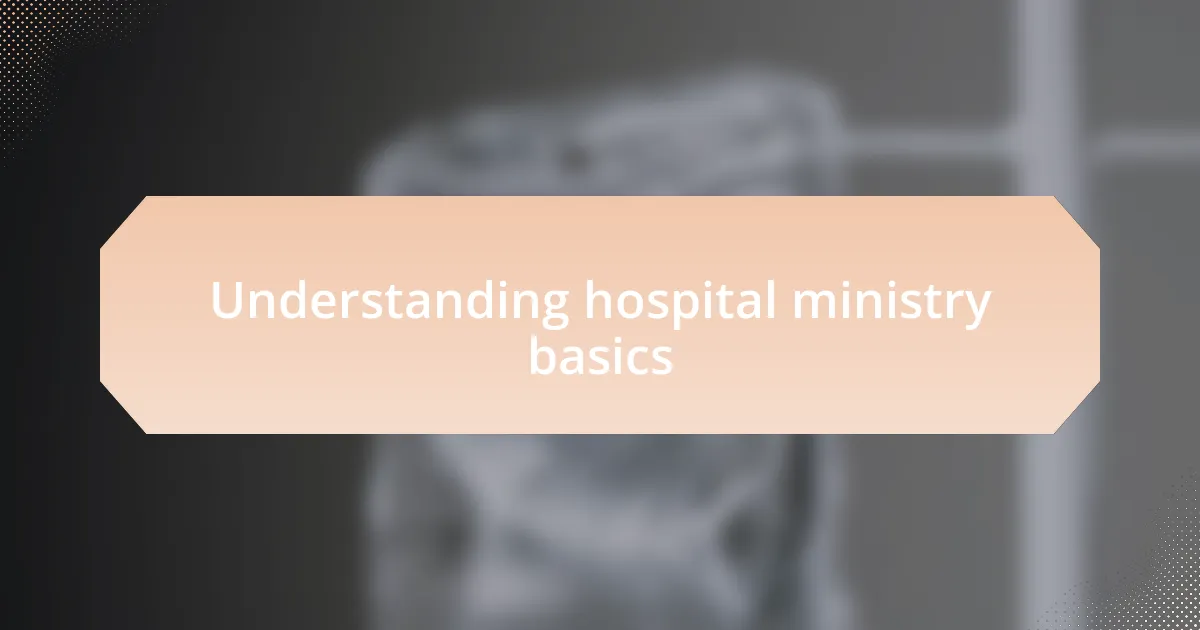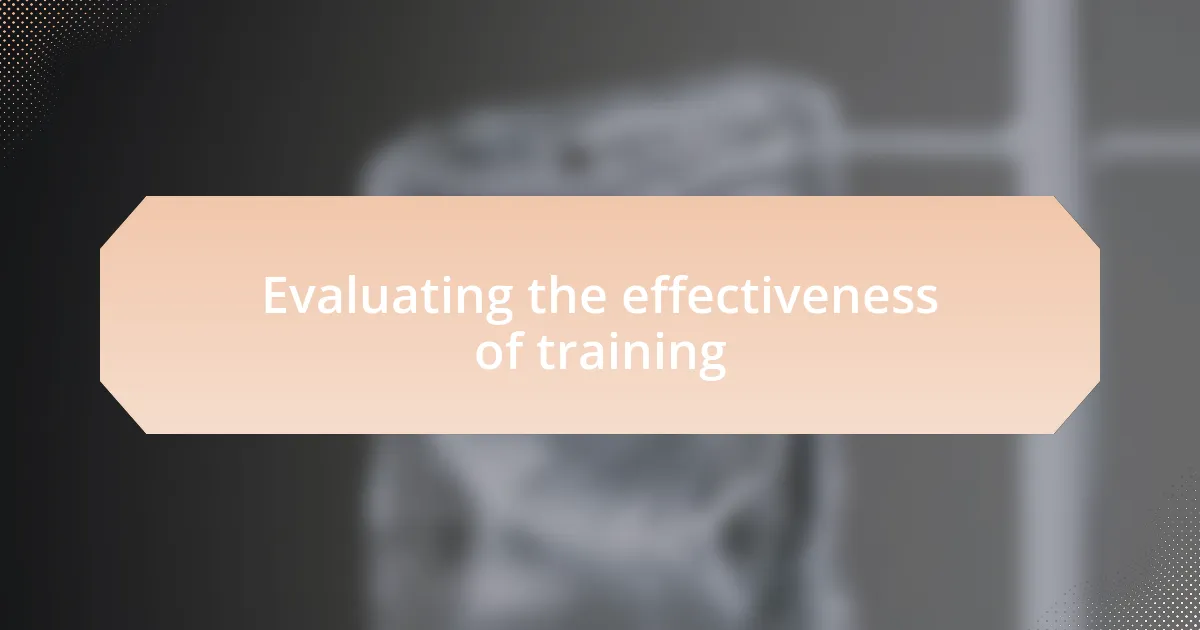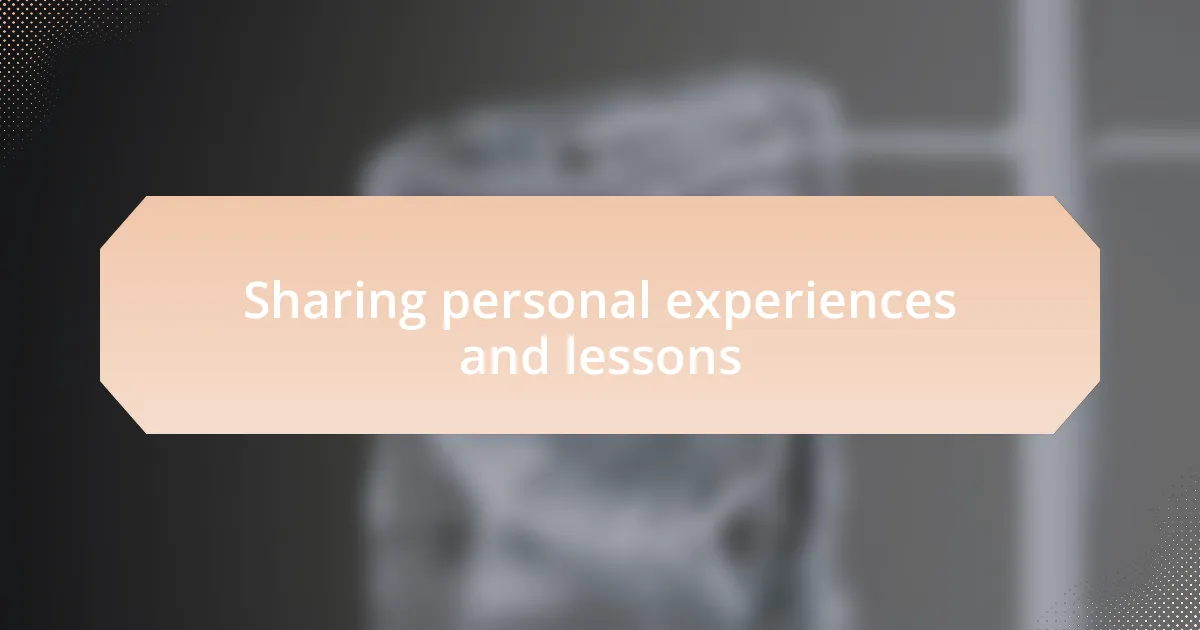Key takeaways:
- Hospital ministry focuses on providing spiritual support, emphasizing empathy and active listening to address patients’ emotional needs.
- Training programs should blend theory with practical experiences, such as role-playing, to prepare volunteers for real-life challenges in hospital settings.
- Continuous evaluation, including feedback and tracking outcomes, is essential for improving the effectiveness of training programs in hospital ministry.
- Sharing personal experiences and storytelling enhances connection among volunteers, fostering a supportive learning environment.

Understanding hospital ministry basics
Hospital ministry is rooted in the mission of providing spiritual support and comfort to patients and their families during some of their most challenging times. I still remember my first visit to a patient in the hospital. It was an overwhelming experience, but then I realized that just being there to listen made a world of difference. Isn’t it amazing how a simple act of presence can create a profound connection?
At its core, hospital ministry transcends traditional religious functions; it’s about being a source of hope and resilience. When I reflect on the moments shared with patients, I often think about the tough questions they face about life and faith. How do we provide reassurance when fear and uncertainty loom large? This is where empathy and active listening play vital roles in our ministry approach.
Moreover, understanding hospital ministry basics involves recognizing the unique challenges of this environment. Each individual we meet has their own story, their own struggles. I’ve seen how a gentle conversation can spark healing, not just physically, but spiritually as well. Have you ever considered how the words we choose can uplift someone in despair? It’s crucial for us to be mindful of our language and availability as we engage in this sacred work.

Identifying needs in hospital ministry
Identifying the specific needs in hospital ministry often requires a deep sense of awareness and observation. I vividly recall a time when I walked into a patient’s room only to find them gazing out the window, lost in thought. It struck me then that sometimes, the greatest need isn’t for words or prayers, but simply for someone to share the silence with them. How do we truly gauge what each person requires in that moment?
Listening becomes a critical tool in this process. On another occasion, I sat with a family who was wrestling with the uncertainties surrounding a major surgery. They expressed concerns that went beyond the medical; they yearned for hope and a sense of clarity. I learned that asking the right questions can open doors to deeper conversations, revealing emotional needs that might otherwise go unnoticed. What if we approached every interaction with an open heart, seeking not just to comfort, but to understand?
Furthermore, I find that diverse backgrounds and experiences influence the needs we encounter. One patient might need spiritual guidance, while another seeks companionship or even a simple confirmation that their feelings are valid. I often reflect on how important it is to tailor our approach. Isn’t it essential that our ministry adapts to honor individual stories and cultures? Recognizing these diverse needs enhances our ability to provide meaningful support.

Designing my training program framework
When I set out to design my training program framework, I started by reflecting on the elements that make our ministry impactful. I remember sketching out a flowchart that represented the journey of a typical patient visit—what concerns they might have and how our interventions could align. In doing this, I realized that each step in the process needed to address both practical knowledge and emotional support, catering to the multifaceted nature of patient care.
Next, I incorporated feedback from volunteers and previous participants to refine the content. One piece of advice stood out to me: “Make it relatable.” This prompted me to include real-life scenarios and case studies that resonate with our mission. I wanted to ensure that the learners could see themselves in those situations, generating empathy and compassion as they navigate their roles in ministry. How could I expect them to connect with patients if they didn’t feel connected to the training itself?
As I pieced together the different components, I focused on creating a blend of theoretical knowledge and hands-on practice. I often thought about the first hospital visit I made. Faced with the overwhelming environment of beeping machines and anxious families, I wished I had experienced something like my training program beforehand. By integrating role-playing exercises and situational simulations, I aimed to give participants a taste of real-life challenges, fostering confidence in their ability to serve effectively. Wouldn’t it be great if each training session felt less like a lecture and more like a shared experience?

Implementing my training program strategies
Implementing my training program strategies required a hands-on approach that mirrored the real-life scenarios our volunteers would encounter. I remember the first time I led a training session; I could see the nervous energy in the room as participants hesitated to share their thoughts. By encouraging open discussions and creating a safe space for sharing, I noticed how quickly the atmosphere shifted—volunteers began to relate their own stories, highlighting the power of vulnerability in our mission.
To maximize engagement, I introduced interactive activities that brought our training concepts to life. For instance, during one session, I organized a mock patient visit where participants had to navigate various challenges while caring for a simulated patient. This immersive experience not only deepened their understanding but also ignited a spark of passion. Have you ever seen that “lightbulb moment” when someone realizes their potential to make a difference? It’s a thrill that words cannot capture.
I also prioritized evaluating and adapting the strategies in real-time. After each training, I would sit down with a cup of coffee, reflecting on what went well and what didn’t. This ongoing process of evaluation enabled me to fine-tune the content continuously, ensuring that our training remains relevant and impactful. My goal was always to inspire confidence and foster a community of learners who feel equipped to handle the complexities of hospital ministry. How rewarding it is to witness participants transform into compassionate caregivers!

Evaluating the effectiveness of training
Evaluating the effectiveness of training is a step that cannot be overlooked. I recall a time when, after a particularly intensive training session, I asked participants to complete a feedback survey. An unexpected comment from one volunteer struck me deeply; they expressed that they felt better equipped to handle challenging situations after our role-playing activities. This feedback reinforced the importance of gauging participant responses to truly understand our impact.
Another method I found beneficial was conducting follow-up interviews a few weeks post-training. I was pleasantly surprised by the enthusiasm my volunteers displayed when discussing how they implemented what they had learned. One volunteer shared how my training helped them navigate a delicate conversation with a patient’s family, allowing them to feel empowered and compassionate in a demanding situation. Have you had a moment where a training session changed your perspective? Those moments are precious and should be cherished.
Tracking outcomes is also essential in evaluating our training programs. I remember collaborating with hospital staff to see how trained volunteers were performing in their roles. When I noticed a significant improvement in patient satisfaction scores tied to our training, it was both rewarding and validating. These insights remind me that our work is not just about numbers; it’s about the stories behind those numbers—stories of care, connection, and compassion in the hospital ministry.

Sharing personal experiences and lessons
I believe the best lessons often come from our own journeys. I remember a time when I was new to hospital ministry; my initial training felt overwhelming. I made rookie mistakes, like using jargon that confused rather than clarified. Reflecting on those moments helped me refine my approach, ensuring I create a welcoming environment for newcomers. Have you ever found growth in your missteps? I certainly did.
One experience that stands out was during a group session when a volunteer shared their struggle in connecting with a patient who had lost a loved one. Their vulnerability opened a rich dialogue, revealing that we all face similar challenges. It reminds me that sharing our experiences fosters an authentic connection, and it’s in those shared vulnerabilities that we learn and grow the most. How often do we let down our guard to be truly honest with each other?
Another lesson I carry with me is the power of storytelling. In one training, I encouraged participants to share their own hospital experiences, and the room filled with powerful narratives. These stories helped participants see the human side of ministry and ignite their compassion. I realized then that our personal stories aren’t just anecdotes; they are transformative tools that enrich our training environment. Have you considered how your own stories could inspire others in their journey?